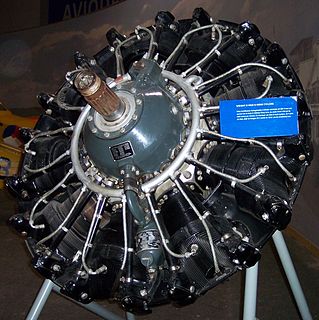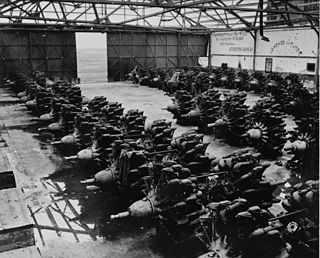
The Hispano-Suiza 12Y was an aircraft engine produced by Hispano-Suiza for the French Air Force before the Second World War. The 12Y became the primary French 1,000 hp (750 kW) class engine and was used in a number of famous aircraft, including the Morane-Saulnier M.S.406 and Dewoitine D.520.

The 12Z, designated Type 89 by the company, was the final evolution of the series of Hispano-Suiza V-12 aircraft engines. The Z model had just entered production when France fell to the Germans during World War II. A small number were produced during the war but the German occupation government would not allow full-scale production to start. After the war small numbers were built to equip new designs, but the rapid introduction of the jet engine ended further development.

The Wright R-1820 Cyclone 9 is an American radial engine developed by Curtiss-Wright, widely used on aircraft in the 1930s through 1950s. It was produced under license in France as the Hispano-Suiza 9V or Hispano-Wright 9V, and in the Soviet Union as the Shvetsov M-25.

The Pratt & Whitney R-1535 Twin Wasp Junior was an engine used in American aircraft in the 1930s. The engine was introduced in 1932 as a 14-cylinder version of the 9-cylinder R-985. It was a two-row, air-cooled radial design. Displacement was 1,535 in³ (25.2 L); bore and stroke were both 5-3/16 in (131.8 mm).

The Hispano-Suiza 8 was a water-cooled V8 SOHC aero engine introduced by Hispano-Suiza in 1914, and was the most commonly used liquid-cooled engine in the aircraft of the Entente Powers during the First World War. The original Hispano-Suiza 8A was rated at 140 hp (100 kW) and the later, larger displacement Hispano-Suiza 8F reached 330 hp (250 kW).

The Bramo 323 Fafnir is a nine-cylinder radial aircraft engine of the World War II era. Based heavily on Siemens/Bramo's earlier experience producing the Bristol Jupiter under license, the Bramo 323 saw limited use.

The Daimler-Benz DB 600 was a German aircraft engine designed and built before World War II as part of a new generation of German engine technology. It was a liquid-cooled inverted V12 engine, and powered the Messerschmitt Bf 110 and Heinkel He 111 among others. Most newer DB engine designs used in WW2 were based on this engine. The decision by the RLM to concentrate on manufacturing aircraft engines using fuel injection systems rather than carburettors meant that the DB 600 was quickly superseded by the otherwise similar DB 601. Later DB series engines grew in bore, stroke, and horsepower, including the DB 603 and DB 605, but were generally similar to the pattern created with the DB 600.

The Gnome-Rhône 14K Mistral Major was a 14-cylinder, two-row, air-cooled radial engine. It was Gnome-Rhône's major aircraft engine prior to World War II, and matured into a highly sought-after design that would see licensed production throughout Europe and Japan. Thousands of Mistral Major engines were produced, used on a wide variety of aircraft.

The Gnome-Rhône 14M was a small 14-cylinder two-row air-cooled radial engine that was used on several French and German aircraft of World War II.

The Gnome-Rhône 14N was a 14-cylinder two-row air-cooled radial engine designed and manufactured by Gnome-Rhône. A development of the pre-war Gnome-Rhône 14K, the 14N was used on several French and German aircraft of World War II.

The Hispano-Suiza 14AB, a.k.a. Hispano-Suiza Type 80, was a 14-cylinder twin-row air-cooled radial engine. In 1929 the Hispano-Suiza company bought a license to produce the Wright Whirlwind engine. The technology from that engine was used to produce a number of different radial engines with greater displacements, power, and number of cylinders.

The Klimov M-103 is a V12 liquid-cooled piston aircraft engine used by Soviet aircraft during World War II.
The Latécoère 611 was a French four-engined maritime reconnaissance flying boat of the Second World War. Although only a single prototype was completed, this served throughout the war, being used by both the Vichy French and Free French navies.

Potez 62 was a French twin-engine civil airliner, designed by Henry Potez in 1934.

The Hispano-Suiza 12X was an aircraft piston engine designed in France by Hispano-Suiza during the early 1930s. A 12-cylinder Vee, liquid-cooled design, the 12X was used on several aircraft types, some of them being used in limited numbers during World War II. Due to the 12X's limited power output, its derivative the more powerful Hispano-Suiza 12Y had a longer career.
One of Avia's own designs, the 1930s Avia Rk.12 was a seven-cylinder radial engine with a rated output of 150 kW (200 hp), built in Czechoslovakia.

The Avia Rk.17 was a 9-cylinder radial aircraft engine, developed from the 7-cylinder Avia Rk.12, with a rated output of 270 kW (360 hp). The Rk.17 was one of Avia's own designs and was built in Czechoslovakia in the 1930s.

The SNECMA 14R was a 14-cylinder two-row air-cooled radial engine developed in France just prior to the start of World War II from the Gnome-Rhône 14N. The 14N radial engine was itself an improved version of the popular pre-war Gnome-Rhône 14K Mistral Major series; designed and manufactured by Gnome et Rhône, a major French aircraft engine manufacturer whose origins pre-date the First World War.

The Hispano-Suiza 18R was an eighteen cylinder high performance water-cooled piston engine, in an 80° W or broad arrow layout, for use in racing aircraft, built in France during the latter half of the 1920s.
Hispano-Suiza piston aero-engines were predominantly piston engines produced by Hispano-Suiza in France, Spain, and under licence in the United Kingdom, the United States and Russia from the First World War through to the 1950s. Development of these engines started with the very successful V-8 engines which introduced many new features which ensured the success of the Hispano-Suiza line.

















